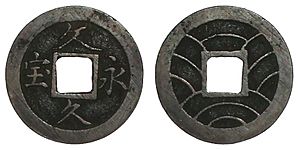Bunkyū facts for kids
Bunkyū (文久) was a Japanese era name (年号,, nengō,, lit. "year name") after Man'en and before Genji. This period spanned the years from February 1861 through February 1864. The reigning emperor was Kōmei-tennō (孝明天皇).
Events of the Bunkyū era
- 1861 (Bunkyu 1): Ukai Gyokusen established the first commercial photography studio (Eishin-dō) in Edo.
- 1861 (Bunkyu 1): Great comet of 1861.
- January 1862 (Bunkyū 1, 12th month): The Bonin Islands (Ogasawara Islands) were confirmed as part of Japan.
- 1862 (Bunkyū 2): The Bunkyū Reforms reduced restrictions on daimyo which had beeb ordered by Ii Naosuke.
- 14 September 1862 (Bunkyū 2, 21st day of the 8th month): Satsuma samurai killed Charles Lennox Richardson at Namamugi on the Tōkaidō road, also known as the Namamugi Incident (Namamugi Jiken).
- 22 April 1863 (Bunkyū 3, 5th day of the 3rd month): Shogun Iemochi traveled in a great procession to the capital. He had been summoned by the emperor, and he had 3,000 retainers as escort.
- 28 April 1863 (Bunkyū 3, 11th day of the 3rd month): Emperor Komei made an Imperial progress to the Kamo Shrines. He was accompanied by the shogun and many feudal lords.
- 15-17 August 1863 (Bunkyū 3, 2nd-4th of the 7th month ): British Bombardment of Kagoshima in retaliation for the death of Charles Lennox Richardson.
Related pages
- National Diet Library, The Japanese Calendar -- historical overview plus illustrative images from library's collection
| Keichō | 1st | 2nd | 3rd | 4th |
|---|---|---|---|---|
| 1861 | 1862 | 1863 | 1864 |
| Preceded by: Man'en |
Era or nengō: Bunkyū |
Succeeded by: Genji |
See also
 In Spanish: Bunkyū para niños
In Spanish: Bunkyū para niños

All content from Kiddle encyclopedia articles (including the article images and facts) can be freely used under Attribution-ShareAlike license, unless stated otherwise. Cite this article:
Bunkyū Facts for Kids. Kiddle Encyclopedia.

